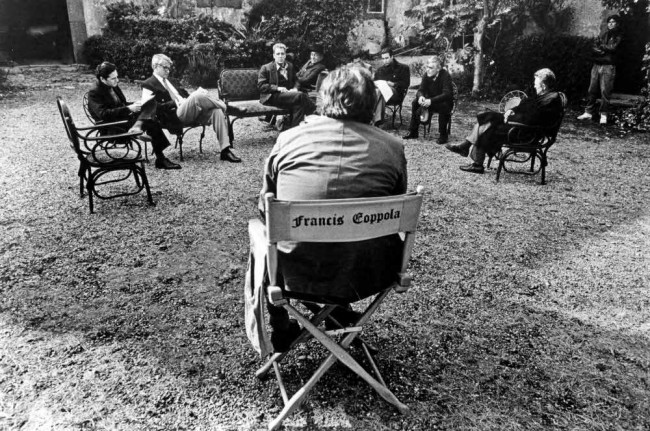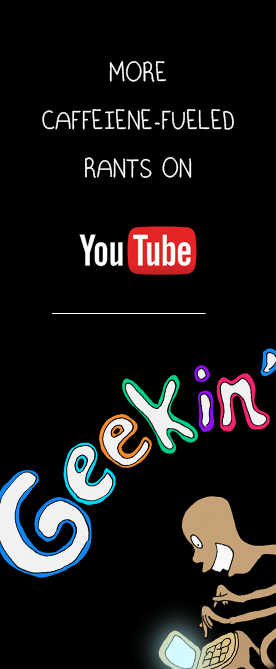I’ve been spending a lot of time at the Museum of the Moving Image. It’s a small, small museum—all but two floors—outfitted with its own theater, which boasts the crispest acoustics I’ve heard in a while. Leading up into the theater is an eerie, vacuumous blue-lit hallway, a low hum playing down upon your ears; like something you’d find in a David Lynch flick—Kyle MacLachlan creeping around the corner. Whoever designed the theater and its entrance did a good job of cutting people off from the city. A womblike experience, for sure.
I met some friends there several weeks back. Two couples. We were there for a full-on marathon: the Godfather movies, back-to-back. But only the first two. The essentials. We were hesitant. Excited, but reluctant. We worried about our backs, our knees, our necks; we worried that the fluid in our joints wouldn’t be able to sustain such massive amounts of movie. It would be eight hours of fidgeting, swiveling, adjusting and re-adjusting our asses.
Curtains shut, lights on, and Nino Rota’s infamous oboe only minutes away, I thought about Part III. I asked my friends if any of them had ever seen it. Sam mentioned that he had. In fact not too long ago. Just the year before, Sam had re-watched all three movies. It was his second time watching Part III. As he recalled: he didn’t mind Part III as a kid. He had read about the outrage, the blasphemous audacity and pride that went into making it, how it had corrupted the other two films of their perfection. But he didn’t care. He thought it was underrated.
But then he re-watched it.
The third film elicits a lot of grief amongst Godfather fans. There are plenty of people out there who refuse to acknowledge it as part of the canon. I, too, have blissfully shunned it from my memory. Perhaps not enough of it. But nearly all of it. Still clinging to the folds of my brain are the famous scenes, the over-quoted scenes—“Just when I thought I was out…THEY PULL ME BACK IN!”—and that beautiful last shot when Michael finally—and literally—keels over. Other than that, the movie is long, plodding, terribly acted, not nearly as well shot and/or lit, and the plot is as riveting as…hmm, to be honest with you, I don’t remember the plot so well, so….
I asked Sam to fill me in with a Twitter-sized synopsis. Sam’s response? Shrug: “Something about the Roman Catholic church.” It was about church corruption and Michael coaxing Kay back into his arms. Maybe. I’m not a 100% sure.
It’s a shame Francis Ford Coppola needed the money as he did. He was never good with spending. An empire always on the brink of crumbling. A man of many indulgences. Just watch his wife’s documentary on the making ofApocalypse Now, Heart of Darkness, or read Peter Biskind’s Easy Riders, Raging Bulls, and you’ll see how he loved to charge through life gut first. By the time the ‘90s rolled around, Coppola’s career was plagued with one financial disaster after the other. The man needed them dolla-dolla bills. And so, Godfather Part III happened; it was born out of a place of hunger, not inspiration. This abomination spawned out of a place of cow-whipped emptiness.
So maybe it’s only appropriate that the film deal so directly with the Catholic Church in all its self-flagellating glory. Because there IS a way of experiencingPart III without sullying the rest of the trilogy.
I think—or rather, I hope….
As my friends and I did during our marathon in order to keep our asses from numbing over with pins and needles of idleness, you have to re-position yourself. You have to rubberneck and take the movie in from a fresh perspective. Which, I know, is asking a lot—given the film’s deplorable quality and tedious running time—but I promise: there’s something to this. Mind you, you don’t have to change your opinion of it. You don’t have to hate it any more or less than you already do. Nor do you necessarily have to re-watch it. All I wish to do is offer balm for the wound. A sprinkle of Holy Water to combat the sacrilegious disgrace. All in the name of sanity. So we may go on with our lives, comfortably, knowing that there’s a third feature in the Godfather saga that isn’t a complete embarrassment.
It’s as simple as this: Lets say you found yourself anxious on the way to an event or a party or some other situation that would normally cause you to break out in mental disarray. What’s the sensation? A little TV fuzz along the skin, just below the epidermis? A fast heart? Sweaty palms? Sound familiar? I hope so (otherwise there wouldn’t be any point to this essay). Now: remember how you feel when you get excited? TV fuzz? Check. Racing heart? Check. Sweaty palms? Check. Same exact symptoms—yet! I think it’s safe to say we’d all prefer excitement over anxiety. Still, if you re-direct your lens, your focus, you’ll see just how interchangeable the two words are. Opposing sides of the same coin.
Now, lets try and apply the same principle to The Godfather Part III.
The Godfather Part III is a pathetic movie. Yes? Can we all agree with that? A sad, sad attempt at cashing in on a classic. The commercialization of art. All boiled down: Part III’s a pitiful endeavor. Coppola’s shooting for money, Gordie Wilson’s losing his eye for light, DuVall’s phased out for highballing the studio, and Pacino’s finally embracing his all-expansive diaphragm. Deplorable, deplorable nonsense. (And yes, you may imagine me shaking my head—or as the kids text: smh). Then you have the film’s most earth-shattering catastrophe: Sofia Coppola. Daughter to Francis Ford—as well as the future director of In Translation and The Bling Ring—Sofia gives one of the most remarkably bad performances imaginable. Nepotism at its finest.
With all these terribly conceived decisions in mind, you can practically hear the movie whistling as it drops from the highest of pedestals, like a suicidal bomber pilot performing kamikaze.
BUT!
What if, tonally, we roll with it? What if we take the pathetic nature of the behind-the-scenes decay, the loss of talent, the misguided development, and make that the movie’s true essence? After all, the movie is about Michael Corleone’s own decline and death. So lets replace Michael Corleone with Coppola and experience the movie that way. Watch the movie again (if you choose) and whenever you see a poor directorial decision or a cringeworthy flourish from Sofia or Andy, use the humiliation you feel for these piss poor performances in order to gauge the humiliation Michael must feel as his body starts to give, as he quits to rely so heavily on the line of communication between his bowels and brain. The real drama—if this movie was made right—is the descent of a family that’s been overwhelmingly preoccupied with their rags-to-riches ascent.
As was Coppola.
A big picture sort of fella, Coppola obsessed over dreams of Zoetrope—his failed production company—becoming a filmmaking haven for all distraught artists looking to maintaining their pure vision. A nice enough idea. However, as Coppola’s name grew in status—like that of an institution—his ego got the better of him. Especially with Apocalypse Now. He got coked out, chewed up, over taxed, harassed; he lost tons of weight; and almost destroyed his marriage, his family, and his reputation as a ‘70s renegade who spun the system however he saw fit. Think about it: he went from making a pair of films about family (The Godfather) to a film about the male ego (Apocalypse Now). Coppola went inward, as Michael does over the course of the trilogy. Michael tears his family apart, loses his wife, kills his brother, and ends up all alone, by his countryside villa, with a couple of household pets milling around his corpse. The man turns into a clown. A whisper of his former self.
So, next time you’re watching The Godfather Part III and feel like hurling some particularly spicy words at the screen, think about the decline of quality, the decline of production value, the decline of Pacino as an actor, Coppola as a director, and Puzo as a writer. Think about Michael Corleone’s decline, as well as the Catholic Church’s. This must all be considered of a piece, before andbehind the lens. The film’s drop in caliber, as well as self-respect, perfectly reflects the Corleone family’s loss of status. The bubble grew, it distended beyond its means, and then it popped.
Just consider it.
And in case you still don’t give a shit about Part III—despite my plea to re-angle your keisters—there’s this phenomenal Italian restaurant—a little family hole—several blocks away from the Museum of the Moving Image worth checking out. Napoli Pizza and Pasta. You’ll stuff yourself into serenity.
Ciao!






